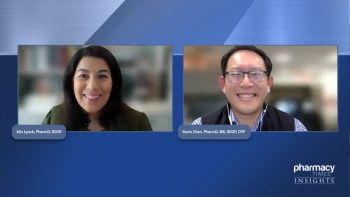
Barriers to Optimal Care for Patients Diagnosed with MDS
Dr Mancini navigates challenges inhibiting patients to receive optimal care amid diagnosis of MDS.
Episodes in this series

Ryan Haumschild, PharmD, MS, MBA: We can’t finish a discussion on myelodysplastic syndrome [MDS] without talking about the unmet needs and future considerations. This is especially true with so much precision medicine and with innovative new therapies. There’s a bright future for this patient population. That’s what I want us to discuss a little more of. I want us to talk about some of the challenges to accessing care but also how we can mitigate those. Mr Mancini, what are some challenges you see with access to care, educating patients, and financial toxicity in this patient population?
Robert Mancini, PharmD, BCOP, FHOPA: Mr Haumschild and Ms Mahmoudjafari mentioned some of these components, which we all deal with. As for access, we already hit on that a little earlier with the transportation issues we mentioned. Many of these products require weekly to every-3-week administration, and that’s enough. If the patient is still transfusion dependent, adding the extra trips and visits on top of that is obviously an additional burden in terms of access.
The products aren’t cheap either. From a financial perspective, as health care providers, we take on a lot of the management of ensuring that prior authorizations are completed and that patients are getting co-pay or free drug assistance when needed. Ensuring that patients can continue on their necessary therapy as long as possible is crucial. How many times have we seen a patient’s insurance change in the middle of their therapy? We have to do this all over again. What does that mean in terms of the potential gap in therapy for these patients because of those unnecessary barriers?
Without transplant, MDS isn’t considered curable. These patients may be on these therapies for years. We want to ensure long-term viability of treatment from a financial standpoint. This often means starting from scratch every year as plans turn over. It’s not as easy as getting them set up and then everything is good to go. We have to follow these patients’ month to month and year to year as they continue therapy. This isn’t just the clinical stuff that we already talked about. It’s all the operational financial and access stuff.
You also asked about patient education. That can be tackled by multiple health care providers, including the prescribers, pharmacists, and nurses who work with these patients. We want to ensure proper education related to not only the administration of the drug but dosing, the intended [effects] as well as adverse effects, and any drug interactions that may occur. We see that a lot with some of the oral agents that Mr Mahmoudjafari mentioned. The importance of adherence was previously mentioned for treatment schedules and any specialty pharmacy requirements, including handling those medications or what to do in case of a missed dose, especially for the oral agents. We can also discuss disease-related management of fatigue—pharmacological as well as nonpharmacological options—for some of our patients. From that perspective, we have a lot that we can offer in terms of improving access, managing access, patient education, and the financial burden.
Ryan Haumschild, PharmD, MS, MBA: Everything you mentioned is so important. In the beginning of our conversation, you talked about how there’s only 1 cure for these patients—a stem cell transplant—but otherwise it’s chronic management of the disease. We sometimes think about chronic management from a high level: cardiovascular [disease] and metabolic syndrome. These patients need that same wrap-around infrastructure. The costs are so high. There are unique considerations when we’re counseling them, and they have to report to us if they’re having transfusion dependency or symptomology. We can make those adjustments, but it’s difficult. It requires a high-touch relationship.
I’m glad that you talked about some of those barriers. Not that we can’t mitigate them, but we need to be aware of what the patient’s journey looks like and how we provide good education at the beginning. This is so they understand their treatment journey—escalations or modifications—and how they might be a normal part of their journey. Also, it’s OK to speak up about different things that are affecting them so we can provide them the best therapeutic plan.
As we’re developing those plans, we also need to utilize the electronic health record [EHR]. That’s a great way to provide wide institutional change and consistency for patients and to give our providers more of a streamlined experience, making their decision-making a lot more front facing, especially when they have so many burdens and responsibilities across all these health systems and community oncology practices. Mr Mahmoudjafari, how are pharmacists utilizing the electronic medical record [EMR] to monitor and check disease progression or track things like infusion dependency?
Zahra Mahmoudjafari, PharmD, BCOP, DPLA: Ryan, you’ve gone through new EMR systems. It’s definitely sophisticated but also complicated. However, we continue to improve every day in terms of how we leverage our EHR to help with monitoring. We have order sites built in with different prescriber and nursing instructions. It’s easier than it’s ever been to ensure that we’re following recommendations. We have access to medical records and other important labs to monitor the disease. In our facility, we have a hematology clinic pharmacist who works beside our physicians and nurse practitioners to help monitor and support our patients. We have medication assistance teams that help with prior authorization paperwork. A village of individuals utilize our tools and resources to improve transition of care, because some patients move to new locations, and ensure that our patients are adequately monitored.
Ryan Haumschild, PharmD, MS, MBA: Many people don’t realize how much goes into an electronic medical record. You both know because you’re heavily involved, but I think about all the build, the clinical review, and the coordination. Sometimes, if it’s not hardwired, you don’t have that standard of care that drives best practice. A lot of times pharmacy is at the forefront. I work with clinical pharmacy specialists like you both who are residency trained and board certified and heavily involved; you’re disease-state experts.
At the same time, informatics pharmacy team members or nursing team members help build out the order sets. There’s a collaboration that has to occur. Someone has to bring that technical knowledge forward to tell us what we’re capable of. Someone can help drive the clinical strategy. Do we want to have alerts if patients have a transfusion? Do we want to create a hard stop where a provider must enter the number of transfusions a patient has had, so they’re asking that patient at each step of the process? How do you monitor transfusion dependency, disease progression, and hemoglobin outside that? Can you pull some of those discrete values, front facing, to the provider when they’re entering in these orders, so they don’t have to search through an EMR? It brings the information to the decision maker. They can review it and provide a timely response. That’s so important. How do we build on it with quality-of-life indicators? As we get these validated scales, our nursing team members, pharmacies, and providers need to make sure that we’re screening the patients for this invaluable information or incorporating it in the treatment plan. Ultimately, we all need to play off that same sheet of music.
Transcript edited for clarity.
Newsletter
Stay informed on drug updates, treatment guidelines, and pharmacy practice trends—subscribe to Pharmacy Times for weekly clinical insights.












































































































































































































